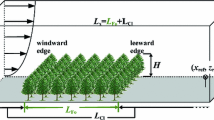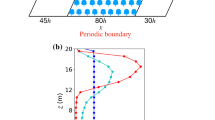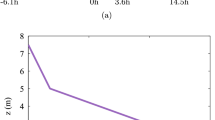Abstract
The aim of this large-eddy simulation study is to improve the yet scarce understanding of the scalar (e.g. \(\hbox {CO}_{2}\)) transport in forest-edge flows. In order to contribute to a basic knowledge on the scalar transport, we focus on idealized neutral flows across a clearing-to-forest transition, with a passive scalar released from a horizontally homogeneous source at the clearing and at the forest floor. Corresponding to previous studies, we found pronounced peaks in scalar concentration and flux downstream of the forest edge, where the flux peak significantly exceeded the given surface flux. We investigated for the first time those transport mechanisms that steer the scalar accumulation, by analyzing the terms in the scalar transport equation. The analysis reveals that the accumulation is accomplished by the streamwise convergence of the mean and turbulent transport. In order to investigate how the concentration and flux enhancement behaves under different conditions, we performed a series of simulations with varying forest density and wind speed. We demonstrate a strong dependence of the peak location and magnitude on forest density. With increasing density, concentration and flux peaks were found closer to the forest edge and peak values increased significantly. Decreasing the wind speed caused an increase of the concentration peak, while the flux peak remained unaffected. For an adequate interpretation and design of micrometeorological measurements near forest edges, it is necessary to identify the regions (fetches) with enhanced concentrations and fluxes. We therefore analyzed different approaches for a proper fetch estimation.











Similar content being viewed by others
Notes
The code can be accessed under http://palm.muk.uni-hannover.de/browser?rev=874.
The corresponding animation is available under http://dx.doi.org/10.5446/14297. It was created with VAPOR, a product of the Computational Information Systems Laboratory at the National Center for Atmospheric Research, www.vapor.ucar.edu.
The related VAPOR animation is available at http://dx.doi.org/10.5446/14311.
The NCAR Command Language (Version 6.1.2) [Software]. (2013). Boulder, Colorado: UCAR/NCAR/CISL/VETS. http://dx.doi.org/10.5065/D6WD3XH5.
References
Asner GP, Scurlock JMO, Hicke JA (2003) Global synthesis of leaf area index observations: implications for ecological and remote sensing studies. Global Ecol Biogeogr 12(3):191–205
Baldocchi D, Falge E, Gu L, Olson R, Hollinger D et al (2001) FLUXNET: a new tool to study the temporal and spatial variability of ecosystem-scale carbon dioxide, water vapor, and energy flux densities. Bull Am Meteorol Soc 82:2415–2434
Belcher SE, Harman IN, Finnigan JJ (2012) The wind in the willows: flows in forest canopies in complex terrain. Annu Rev Fluid Mech 44:479–504
Belcher SE, Jerram N, Hunt JCR (2003) Adjustment of a turbulent boundary layer to a canopy of roughness elements. J Fluid Mech 488:369–398
Bergström H, Högström U (1989) Turbulent exchange above a pine forest ii. organized structures. Boundary-Layer Meteorol 49:231–263
Brunet Y, Irvine MR (2000) The control of coherent eddies in vegetation canopies: streamwise structure spacing, canopy shear scale and atmospheric stability. Boundary-Layer Meteorol 94(1):139–163
Cassiani M, Katul GG, Albertson JD (2008) The effects of canopy leaf area index on airflow across forest edges: large-eddy simulation and analytical results. Boundary-Layer Meteorol 126:433–460
Coceal O, Belcher SE (2004) A canopy model of mean winds through urban areas. Q J R Meteorol Soc 130:1349–1372
Deardorff JW (1980) Stratocumulus-capped mixed layers derived from a three-dimensional model. Boundary-Layer Meteorol 18:495–527
Dupont S, Brunet Y (2008) Edge flow and canopy structure: a large-eddy simulation study. Boundary-Layer Meteorol 126:51–71
Dupont S, Brunet Y (2009) Coherent structures in canopy edge flow: a large-eddy simulation study. J Fluid Mech 630:93–128
Dupont S, Irvine MR, Bonnefond JM, Lamaud E, Brunet Y (2012) Turbulent structures in a pine forest with a deep and sparse trunk space: stand and edge regions. Boundary-Layer Meteorol 143:309–336
Edburg SL, Stock D, Lamb BK, Patton EG (2012) The effect of the vertical source distribution on scalar statistics within and above a Forest Canopy. Boundary-Layer Meteorol 142:365–382
Finnigan JJ (2000) Turbulence in plant canopies. Annu Rev Fluid Mech 32:519–571
Finnigan JJ, Brunet Y (1995) Turbulent airflow in forests on flat and hilly terrain. In: Coutts MP, Grace J (eds) Wind and trees. Cambridge University Press, Cambridge, 340 pp
Finnigan JJ, Shaw RH, Patton EG (2009) Turbulence structure above a vegetation canopy. J Fluid Mech 637:387–424
Foken T, Meixner FX, Falge E, Zetzsch C, Serafimovich A, Bargsten A, Behrendt T, Biermann T, Breuninger C, Dix S, Gerken T, Hunner M, Lehmann-Pape L, Hens K, Jocher G, Kesselmeier J, Lers J, Mayer JC, Moravek A, Plake D, Riederer M, Rtz F, Scheibe M, Siebicke L, Srgel M, Staudt K, Trebs I, Tsokankunku A, Welling M, Wolff V, Zhu Z (2012) Coupling processes and exchange of energy and reactive and non-reactive trace gases at a forest site results of the EGER experiment. Atmos Chem Phys 12:1923–1950
Gao W, Shaw RH, Paw UKT (1989) Observation of organized structures in turbulent flow within and above a forest canopy. Boundary-Layer Meteorol 47:349–377
Garratt JR (1990) The internal boundary layer—a review. Boundary-Layer Meteorol 50:171–203
Huang J, Cassiani M, Albertson JD (2009) The effects of vegetation density on coherent turbulent structures within the canopy sublayer: a large-eddy simulation study. Boundary-Layer Meteorol 133:253–275
Huang J, Cassiani M, Albertson JD (2011) Coherent turbulent structures across a vegetation discontinuity. Boundary-Layer Meteorol 140:1–22
Kanani F, Träumner K, Ruck B, Raasch S (2014) What determines the differences found in forest edge flow between physical models and atmospheric measurements? - An LES study. Meteorol Z 23(1):33–49
Kanda M, Hino M (1994) Organized structures in developing turbulent flow within and above a plant canopy, using a large-eddy simulation. Boundary-Layer Meteorol 68:237–257
Katul GG, Finnigan JJ, Poggi D, Leuning R, Belcher SE (2006) The influence of hilly terrain on canopy-atmosphere carbon dioxide exchange. Boundary-Layer Meteorol 118:189–216
Klaassen W, Sogachev A (2006) Flux footprint simulation downwind of a forest edge. Boundary-Layer Meteorol 121:459–473
Klaassen W, Van Breugel PB, Moors EJ, Nieveen JP (2002) Increased heat fluxes near a forest edge. Theor Appl Climatol 72:231–243
Lu CH, Fitzjarrald DR (1994) Seasonal and diurnal variations of coherent structures over a deciduous forest. Boundary-Layer Meteorol 69:43–69
Monin AS, Obukhov AM (1954) Osnovnye zakonomernosti turbulentnogo peremeshivanija v prizemnom sloe atmosfery (Basic laws of turbulent mixing in the atmosphere near the ground). Tr Akad Nauk SSSR Geophys Inst 24:163–187
Poggi D, Porporato A, Ridolfi L, Albertson JD, Katul GG (2004) The effect of vegetation density on canopy sub-layer turbulence. Boundary-Layer Meteorol 111:565–587
Raasch S, Schröter M (2001) Palm—a large-eddy simulation model performing on massively parallel computers. Meteorol Z 10:363–372
Raupach MR, Finnigan JJ, Brunet Y (1996) Coherent eddies and turbulence in vegetation canopies: the mixing-layer analogy. Boundary-Layer Meteorol 78:351–382
Ross AN (2011) Scalar transport over forested hills. Boundary-Layer Meteorol 141:179–199
Ross AN, Baker TP (2013) Flow over partially forested ridges. Boundary-Layer Meteorol 146:375–392
Schumann U, Sweet RA (1988) Fast Fourier transforms for direct solution of Poissons equation with staggered boundary conditions. J Comput Sci 75:123–137
Shaw RH, Patton EG (2003) Canopy element influences on resolved- and subgrid-scale energy within a large-eddy simulation. Agric For Meteorol 115:5–17
Shaw RH, Schumann U (1992) Large-eddy simulation of turbulent flow above and within a forest. Boundary-Layer Meteorol 61:47–64
Shaw RH, Seginer I (1985) The dissipation of turbulence in plant canopies. In: Proceedings of the 7th symposium of the American Meteorological Society on Turbulence and diffusion. Boulder, CO, pp 200–203
Shaw RH, Brunet Y, Finnigan JJ, Raupach MR (1995) A wind tunnel study of air ow in waving wheat: two-point velocity statistics. Boundary-Layer Meteorol 76:349–376
Sogachev A, Leclerc MY, Zhang G, Rannik Ü, Vesala T (2008) CO\(_{2}\) fluxes near a forest edge: a numerical study. Ecol Appl 18(6):1454–1469
Steiner AL, Pressley SN, Botros A, Jones E, Chung SH, Edburg SL (2011) Analysis of coherent structures and atmosphere-canopy coupling strength during the CABINEX field campaign. Atmos Chem Phys 11:11921–11936
Su HB, Shaw RH, Paw UKT (2000) Two-point correlation analysis of neutrally stratified flow within and above a forest from large-eddy simulation. Boundary-Layer Meteorol 49:423–460
Su HB, Shaw RH, Paw UKT, Moeng CH, Sullivan PP (1998) Turbulent statistics of neutrally stratified flow within and above a sparse forest from large-eddy simulation and field observations. Boundary-Layer Meteorol 88:363–397
Träumner K, Wieser A, Ruck B, Frank C, Röhner L, Kottmeier C (2012) The suitability of Doppler lidar for characterizing the wind field above forest edges. Forestry 85:399–412
Watanabe T (2004) Large-eddy simulation of coherent turbulence structures associated with scalar ramps over plant canopies. Boundary-Layer Meteorol 112:307–341
Wicker L, Skamarock W (2002) Time-splitting methods for elastic models using forward time schemes. Mon Weather Rev 130:2088–2097
Williamson JH (1980) Low-storage Runge–Kutta schemes. J Comput Phys 35:48–56
Yang B, Raupach MR, Shaw RH, Paw UKT, Morse AP (2006) Large-eddy simulation of turbulent flow across a forest edge. Part I: flow statistics. Boundary-Layer Meteorol 120:377–412
Yang B, Morse AP, Shaw RH, Paw UKT (2006) Large-eddy simulation of turbulent flow across a forest edge. Part II: momentum and turbulent kinetic energy budgets. Boundary-Layer Meteorol 121:433–457
Acknowledgments
This study was supported by the German Research Foundation (DFG) under grant RA 617/23-1. All simulations were performed on the SGI Altix ICE at The North-German Supercomputing Alliance (HLRN) in Hannover and Berlin. NCLFootnote 4 and VAPOR have been used for data analysis and visualization. We thank the two anonymous reviewers for their detailed comments that helped to improve this manuscript.
Author information
Authors and Affiliations
Corresponding author
Rights and permissions
About this article
Cite this article
Kanani-Sühring, F., Raasch, S. Spatial Variability of Scalar Concentrations and Fluxes Downstream of a Clearing-to-Forest Transition: A Large-Eddy Simulation Study. Boundary-Layer Meteorol 155, 1–27 (2015). https://doi.org/10.1007/s10546-014-9986-3
Received:
Accepted:
Published:
Issue Date:
DOI: https://doi.org/10.1007/s10546-014-9986-3




